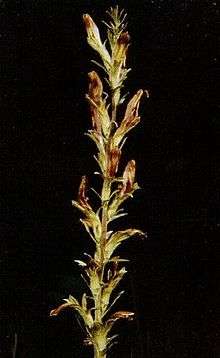Schwalbea
| Schwalbea | |
|---|---|
 | |
| Scientific classification | |
| Kingdom: | Plantae |
| (unranked): | Angiosperms |
| (unranked): | Eudicots |
| (unranked): | Asterids |
| Order: | Lamiales |
| Family: | Orobanchaceae |
| Genus: | Schwalbea L.[1] |
| Species: | S. americana |
| Binomial name | |
| Schwalbea americana L.[2] | |
Schwalbea is a genus of flowering plants in the family Orobanchaceae, with a single species, Schwalbea americana, or American chaffseed, an erect, hemiparasitic, perennial herb that grows 1.0-2.6 ft (0.3-0.8 m) in height. Although it is a root-hemiparasite (partially dependent on its host), the species is not host-specific and may parasitize a variety of trees, shrubs, and herbs. April through June flowers are pollinated by bees, with fruits maturing in July–September. Fruit dispersal is poorly understood, but fruits are likely wind dispersed in close proximity to the parent. Requirements for seed germination and seedling establishment are unknown, but the species is considered shade-intolerant. Fire may play a role in establishing the parasite-host connection.this plant also is endangered of being extinct.
Life cycle
The American chaffseed, with its hemiparasitic behavior, is considered to be one of the rarest root-parasite species of flowering plants in the southeastern U.S. Although it is not host-specific, a host is required and may be a wide variety of woody and herbaceous plants.
Showy, insect-pollinated flowers occur May–June, with fruits maturing in August. Fruit is a brown, dry dehiscent capsule, narrowly oval-shaped, about 0.4 inches (1 cm) long. Seeds are numerous, flat, and winged. Fire appears to be a requirement for long-term viability strongly affecting the reproductive success by controlling conditions necessary for successful seed germination and possibly required for young plants to make their haustorial connection. The few brief months immediately following a fire are enough time for the minute seeds to germinate in the mineral soil under full sun without litter and competing vegetation. The coarse, thickened chaffseed capsule insulates the seeds from the higher temperature of the fire and the heat exposure may increase germination rates.
Taxonomy
Schwalbea americana was first described by Carl Linnaeus in 1753.[2] It is considered to be the sole species in the genus. A further species, Schwalbea australis was described by Francis Whittier Pennell in a 1920 publication,[3] but is now usually treated as the variety of Schwalbea americana var. australis.[4]
Distribution and habitat
American chaffseed typically grows in sandy (sandy peat, sandy loam), acidic, seasonally moist to dry soils. It is generally found in habitats described as open, moist pine flatwoods, pine/wiregrass savannas, and ecotonal areas between peaty wetlands and xeric sandy soils. All of these habitats were historically maintained by human or lightning-caused wildfires. These habitats are species-rich with grasses, sedges, and savanna dicots being especially numerous (USFWS 1994). Natural communities which could support American chaffseed in North Carolina include mesic pine flatwoods, pine/scrub oak sandhills, pine savannas, and Sandhills Seeps.
Status and conservation

American chaffseed, a monotypic genus, was listed as Federally Endangered September 29, 1992.[5]
Historically, the species occurred in Tennessee, Kentucky, and the inner and outer Coastal Plain of 15 eastern and southeastern states.
The present distribution is restricted to just five states; Florida, Georgia, North Carolina, South Carolina and New Jersey. Range wide, 71 extant populations have been identified, but most are small in plant numbers and area covered.
In North Carolina, there are 18 extant occurrences, 17 of which occur on Fort Bragg. The impact areas support large occurrences of American chaffseed due to frequent fires, establishing Fort Bragg as one of three population centers for the species, the other two being eastern South Carolina and southwestern Georgia/northwestern Florida. Seventeen occurrences on Fort Bragg represent the only known population(s) in North Carolina, except for a very small population in Moore County, just off the installation. Outside of the impact areas, four sites occur, and numbers of individuals are small. Burning of these sites is less frequent than in impact areas. Even on sites with only low herbaceous species densities, American chaffseed occurrences on Fort Bragg decline in the absence of frequent fires, indicating that competition may be influencing these sites less than fire.[6]
Recovery plan
A recovery plan was launched on September 29, 1995 by the U.S. Fish and Wildlife Service and the U.S. Department of the Interior.
Goal
"To remove American chaffseed from the Federal list if endangered and threatened wildlife and plants."
Objectives
The immediate objective of the recovery program is to reclassify the American chaffseed from endangered to threatened based upon improvements in its status. The ultimate objective of the recovery program is to delist American chaffseed by ensuring long-term viability of the species.
Criteria
American chaffseed will be considered for reclassification when:
- at least 50 viable sites, distributed throughout the current range of the species, are provided permanent long-term protection;
- four of the 50 sites are located in the northern portion of the species range (Massachusetts to Virginia);
- management agreements or plans are in place for all 50 of the protected sites;
- life history and ecological requirements are understood sufficiently to determine viability of extant populations; and
- biennial monitoring shows that the 50 sites are viable over a 10-year period.
Actions needed
- Protect extant populations and manage habitats.
- Expand the extent of American chaffseed in the northern portion of current range.
- Investigate best management techniques.
- Investigate the species’ biology.
- Investigate genetic variability.
- Monitor populations.
References
- ↑ "IPNI Plant Name Details for Schwalbea L.". The International Plant Names Index. Retrieved 2016-03-02.
- 1 2 "IPNI Plant Name Details for Schwalbea americana L.". The International Plant Names Index. Retrieved 2016-03-02.
- ↑ "IPNI Plant Name Details for Schwalbea australis Pennell". The International Plant Names Index. Retrieved 2016-03-02.
- ↑ "Schwalbea americana var. australis (Pennell) Reveal & C.R. Broome". Tropicos. Missouri Botanical Garden. Retrieved 2016-03-02.
- ↑ USFWS 1992
- ↑ TNC 1993
